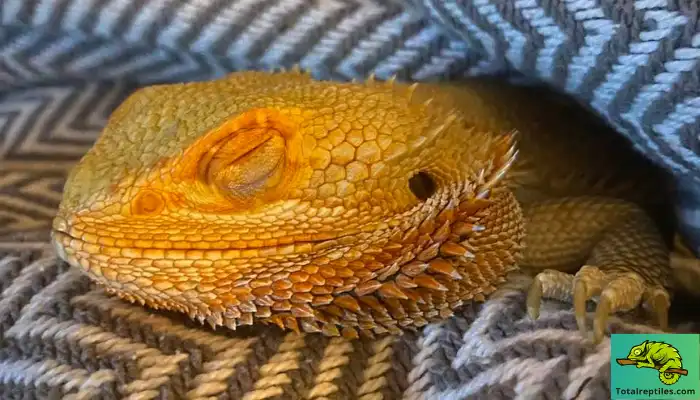It’s a fair question! While some pictures of bearded dragons burrowing into blankets look incredibly cute, reptiles have different needs than us mammals. As cold-blooded creatures, these lizards can’t regulate their own body temperature. So, how exactly do blankets impact bearded dragons?
As a fellow bearded dragon lover, I get the urge to wrap up these adorable lizards in a cozy blanket. Their adorable faces make you want to cuddle! But before you tuck your scaly friend in for the night, you may be wondering—do bearded dragons like blankets?
In this article, we’ll uncover the truth about bearded dragons and blankets. You might be surprised to learn whether blankets actually keep beardies warm or if they’re just for adorable photo ops!

Do Bearded Dragons Get Warm Under Blankets?
I know it seems counterintuitive, but wrapping bearded dragons in blankets actually doesn’t warm them up at all! You see, bearded dragons are cold-blooded reptiles. Unlike us mammals, their bodies don’t produce their own internal heat. Instead, beardies rely entirely on external temperatures to regulate their body heat.
Why is this relevant to blankets?
Well, a blanket traps the air between it and the bearded dragon’s body. If the lizard is already cold, a blanket just traps that lower body temperature next to the skin.
Put simply – blankets alone don’t generate heat for bearded dragons! They only retain whatever temperature is already present.
To properly warm, you need an external heating source like:
- A heat lamp overhead
- An under-tank heating pad
- A hot pack or water bottle tucked under the blanket
Without a supplemental heat source, a bearded dragon wrapped in a blanket will just get colder! The trapped air prevents heat absorption from the warmer room.
It seems backward from how blankets work for us. But for these cold-blooded critters, blankets truly don’t provide any warmth.
Never use blankets alone to warm a chilly bearded dragon. You could accidentally make your cold-blooded friend even colder! Always pair blankets with a heat source to keep the temperature in the optimal zone.
Do Bearded Dragons Need a Soft Place to Sleep?
When prepping your bearded dragon’s habitat, you may wonder if they need plush, cushy bedding. While some beardies enjoy the comfort of a soft blanket, others are just fine snoozing on harder surfaces.
In the wild, beardies sleep in rock crevices and compact dirt burrows without much padding. So soft bedding isn’t a requirement for their health and wellbeing.
That said, many pet bearded dragons love the feeling of plush fabrics! It provides stimulating sensory input and a sense of security.
You can experiment with different textiles to see which looks best. Good options are soft cotton, fleece, flannel, and T-shirt scraps.
Just be sure to choose fabrics without any loose threads or choking hazards. And don’t use blankets to warm bearded dragons – they don’t generate heat alone!

Why bearded dragons enjoy blankets?
While the warming effect is a myth, there are a few valid reasons why your bearded dragon might snuggle up in a blanket, even without a heat source.
For Comfort and Coziness
Bearded dragons come from very dry desert regions without much softness in their environment. In captivity, many beardies discover that plush blankets feel pleasing!
The soft, cushy texture is a new sensation that they enjoy curling up in. It’s kind of like when we wrap up in a fuzzy blanket or snuggle under the covers – it just feels cozy!
So, while they don’t need plush bedding, bearded dragons often do appreciate the comforting texture. The pressure and tactile stimulation makes them feel secure.
For Hiding and Sleeping
In the wild, bearded dragons squeeze into rock crevices, animal burrows, and other snug hiding spots to sleep safely away from predators.
Your pet retains this instinct to hide while sleeping. A blanket provides cover that makes your lizard feel more secure settling down for a nap.
So if your beardie seems to sleep under their blanket constantly, they likely equate it with a comfortable, protected place to get some shut-eye!
To Introduce Your Scent
Bearded dragons have a strong sense of smell. In the wild, they become familiar with local scents as “safe” and unfamiliar odors as potentially “unsafe.”
When you handle a blanket frequently, your scent rubs off on the fabric. Placing this blanket in the habitat helps familiarize them with your odor.
Over time, your smell becomes associated with comfort and security. Your bearded dragon bonds with you as their caretaker.
To Retain Heat From a Source
Bearded dragons can benefit from a blanket with an external heating source. For example, if you place a heated rice sock under the blanket, your bearded dragon absorbs that soothing warmth through the fabric. The insulation traps the heat close to their body.
A blanket also retains your beardie’s natural body warmth if they’ve recently basked under a heat lamp. While blankets don’t warm bearded dragons up, they still enjoy the cozy comfort, security, scent associations, and heat retention that bedding provides.
Signs Your Bearded Dragon Likes Its Blanket
Bearded dragons have unique personalities – yours may love blanketing, while another could be indifferent. How can you tell if your beardie enjoys their blanket? Watch for these behaviors that show your blanket makes you feel safe and cozy:

Curling Up Inside
If your bearded dragon actively burrows into folds and curls up under their blanket, they probably find it comforting! Voluntarily slipping under the cover signals this is their blanket of choice for naps and relaxation.
Seeking It Out
Repeatedly returning to rest on the same blanket, even when other bedding options are available, is very telling.
Relaxed Demeanor
Notice your bearded dragon’s eyes gently close and their muscles relax beneath the blanket. Peaceful sleep and a Zen-like state show this is quality snuggle time for your reptile buddy.
Positive Body Language
Look for subtle leaning into the blanket, small head rubs, and foot grips pricking the fabric.
Your bearded dragon will exhibit signs they actively enjoy and want to interact with a blanket they consider a happy, comforting space.
choosing safe blanket materials for bearded dragons
When selecting materials, focus on soft, flexible fabrics that won’t snag claws or teeth. The right textures will make your bearded dragon feel pampered!
Soft Fabrics
Good blanket fabrics include:
- Fleece
- Flannel
- High-pile plush
- Soft cotton
- Natural wool
- T-shirt material
These softly woven materials provide the cozy, snuggly texture bearded dragons love without any scratchy or stiff sensations. Avoid bedding made from burlap, rough terrycloth, or scratchy metallic weaves. The coarser texture could irritate delicate reptile skin.
Avoid Loose Threads
Check blanketing for loose threads that could catch on your bearded dragon’s claws or teeth. Use a lint roller before placing any blankets in the habitat.
If threads do snag and start unraveling, either trim them or retire the blanket to avoid any entanglement risks. Safety first!
Steer Clear of Choking Hazards
Avoid any small attachments on blankets like rhinestones, buttons, or appliques. Reptiles may try biting at these, causing a choking risk.
Also, be sure the fabric doesn’t have any edible-looking print, like animal shapes or food designs. Your curious lizard could mistake these for real prey or food!
With some careful selection, you can find the perfect soft, cozy blankets for your bearded dragon to snuggle up in safely.
Conclusion
Few sights are cuter than a bearded dragon all bundled up in a blanket. But now you know blankets don’t warm up these cold-blooded reptiles! While they can’t generate their heat, bearded dragons do enjoy blankets for comfort, security, and retaining heat from other sources.
The key is to always pair blankets with supplemental heating like ceramic bulbs, heat pads, or hot water bottles. This ensures your beardie stays nice and toasty. Blanket-loving bearded dragons will exhibit signs like curling up inside, seeking it out repeatedly, and appearing calm and relaxed. Pick soft, loose-thread-free fabrics for safety and coziness.
And be sure to provide other warm, secure sleeping spaces like textured tiles or snug hide boxes. Proper heating and habitat layout prevent issues like lethargy.

